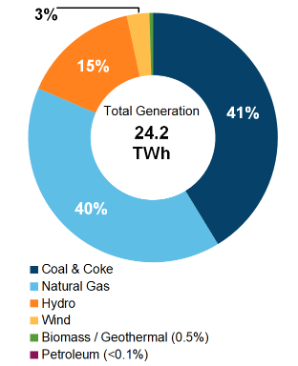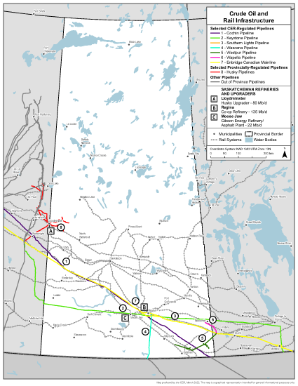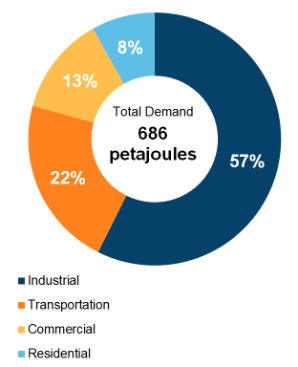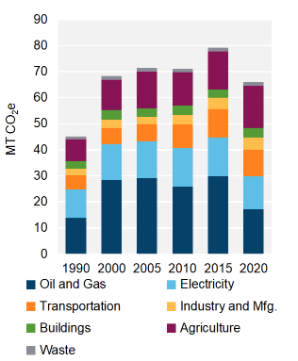Provincial and Territorial Energy Profiles – Saskatchewan

On this page:
Connect/Contact Us
Please send comments, questions, or suggestions to
energy-energie@cer-rec.gc.ca
-
Figure 1: Hydrocarbon Production
Source and Description:
Source:
CER – Estimated Production of Canadian Crude Oil and Equivalent and Marketable Natural Gas Production in CanadaDescription:
This graph shows hydrocarbon production in Saskatchewan from 2013 to 2023. Crude oil production has decreased from 486 MMb/d to 457 MMb/d. Natural gas production has deceased from 0.41 Bcf/d to 0.31 Bcf/d. -
Figure 2: Electricity Generation by Fuel Type (2021)
Source and Description:
Source:
CER – Canada's Energy Future 2023 Data Appendix for Electricity GenerationDescription:
This pie chart shows electricity generation by source in Saskatchewan. A total of 24.9 TWh of electricity was generated in 2021. -
Figure 3: Crude Oil Infrastructure Map
Source and Description:
Source:
CERDescription:
This map shows major CER-regulated crude oil pipelines, rail lines, and refineries in Saskatchewan.Download:
PDF version [1,478 KB] -
Figure 4: Natural Gas Infrastructure Map
Source and Description:
Source:
CERDescription:
This map shows major CER-regulated natural gas pipelines in Saskatchewan.Download:
PDF version [887 KB] -
Figure 5: End-Use Demand by Sector (2020)
Source and Description:
Source:
CER – Canada's Energy Future 2023 Data Appendix for End-Use DemandDescription:
This pie chart shows end-use energy demand in Saskatchewan by sector. Total end-use energy demand was 650 PJ in 2020. The largest sector was industrial at 60% of total demand, followed by transportation (at 19%), commercial (at 13%), and lastly, residential (at 8%). -
Figure 6: End-Use Demand by Fuel (2020)
Source and Description:
Source:
CER – Canada's Energy Future 2023 Data Appendix for End-Use DemandDescription:
This figure shows end-use demand by fuel type in Saskatchewan in 2020. Natural gas accounted for 303 PJ (47%) of demand, followed by refined petroleum products at 253 PJ (39%), electricity at 83 PJ (13%), biofuels at 11 PJ (2%), and other at 0 PJ.
Note: "Other" includes coal, coke, and coke oven gas. -
Figure 7: GHG Emissions by Sector
Source and Description:
Source:
Environment and Climate Change Canada – National Inventory Report 1990-2022Description:
This stacked column graph shows GHG emissions in Saskatchewan by sector from 1990 to 2022 in MT of CO2e. Total GHG emissions have increased in Saskatchewan from 49.0 MT of CO2e in 1990 to 75.9 MT of CO2e in 2022. -
Figure 8: Emissions Intensity from Electricity Generation
Source and Description:
Source:
Environment and Climate Change Canada – National Inventory Report 1990-2022Description:
This column graph shows the emissions intensity of electricity generation in Saskatchewan from 1990 to 2022. In 1990, electricity generated in Saskatchewan emitted 800 g of CO2e per kWh. By 2022, emissions intensity decreased to 630 g of CO2e per kWh.
Energy Production
Crude Oil
- In 2023, Saskatchewan produced 457.0 thousand barrels per day (Mb/d) of crude oil (including condensate and pentanes plus) (Figure 1). Saskatchewan is the second largest crude oil producing province in Canada after Alberta, accounting for 9% of Canada’s crude oil production in 2023.
- Saskatchewan mainly produces heavy oil. In 2023, Saskatchewan produced 296.5 Mb/d of conventional heavy oil and 157.0 Mb/d of conventional light oil. Saskatchewan’s lighter crudes are produced primarily from tight wells.
- Most of the growth in Saskatchewan’s oil production from 2010 to 2015 was from tight oil. Since then, production is increasingly coming from new thermal heavy oil projects. Thermal heavy oil projects apply steam-assisted gravity drainage (SAGD) to heavy oil fields primarily in the Lloydminster area.
- Saskatchewan also has two commercial-scale carbon dioxide enhanced oil recovery (EOR) developments at Weyburn and Midale. The two projects inject roughly two megatonnes of carbon dioxide annually.Footnote 1 The carbon dioxide comes from the Boundary Dam Power Station in Estevan and the Great Plains Synfuels plant in North Dakota.
- Cenovus’s Lloydminster UpgraderFootnote 2 converts heavy oil from Saskatchewan and Alberta to synthetic oil and produces some diesel fuel. The upgrader has the capacity to process 81.5 Mb/d of heavy oil.
- Saskatchewan’s remaining resource of crude oil is estimated to be 7.6 billion barrels as of December 2021.Footnote 3
Refined Petroleum Products (RPPs)
- There are two refineries in Saskatchewan with a combined capacity of 152 Mb/d: Federated Co-operatives Limited’s (FCL) Co-op Refinery ComplexFootnote 4 in Regina and Gibson Energy’s Moose JawFootnote 5 facility. Both refineries consume western Canadian crude oil.
- The Co-op Refinery has a capacity of 130 Mb/d and produces a variety of RPPs, such as gasoline, diesel, and heavy fuel oil. The Co-op Refinery also has an upgrader to process heavy oil into lighter, synthetic crude oil.
- FCL has proposed a new renewable diesel plant adjacent to the Co-op Refinery, designed to manufacture up to 15 Mb/d of renewable diesel.Footnote 6
- The Moose Jaw Refinery has a capacity of 22 Mb/d. It processes heavy crude oil into a variety of products, such as asphalt.
- Saskatchewan produces a net surplus of RPPs. Some RPPs are transferred to Alberta and Manitoba, and small volumes are also exported to the United States (U.S.).
Natural Gas/Natural Gas Liquids (NGLs)
- In 2023, natural gas production in Saskatchewan averaged 309.7 million cubic feet per day (MMcf/d) (Figure 1). Saskatchewan produced 2% of Canada’s total natural gas production in 2023.
- Historically, most natural gas production came from wells in the southwest corner of Saskatchewan. An increasing amount of natural gas is now produced elsewhere in the province as a byproduct of oil production (solution gas) from the Viking Formation, the Bakken Formation, and other formations that produce tight oil.
- Saskatchewan’s total potential for recoverable, sales-quality gas is estimated to be 13.4 trillion cubic feet (Tcf), with 4.7 Tcf remaining at year-end 2021.Footnote 7
Electricity
- In 2021, Saskatchewan generated 24.9 terawatt-hours (TWh) of electricity (Figure 2), which is approximately 4% of total Canadian generation. Saskatchewan had an estimated generating capacity of 4,602 megawatts (MW) in 2021.
- SaskPower generates most of the electricity in Saskatchewan. Large independent power producers account for roughly 25% of generation capacity and sell bulk power from gas, hydro, wind, and solar generation to SaskPower through power purchase agreements.Footnote 8
- In 2021, 86% of electricity in Saskatchewan was produced from fossil fuels: 44% from natural gas, 41% from coal, and a small amount of petroleum used in remote off-grid communities.Footnote 9 The remaining 14% is produced from renewables, primarily hydroelectricity.
- Saskatchewan’s two largest power stations are coal-fired. The Poplar River Power Station is in Coronach and has 582 MW of capacity.Footnote 10 The Boundary Dam Power StationFootnote 11 is in Estevan and has 531 MW of capacity.Footnote 12 A portion of Boundary Dam’s capacity (120 MW) is already fitted with carbon capture and storage.
- Saskatchewan has about 889 MW of hydroelectric capacity. The facilities are scattered across the province with some as far north as Lake Athabasca in northwest Saskatchewan.
- Southern Saskatchewan has some of the highest solar photovoltaic potential in Canada, with Regina and Saskatoon receiving an average 7.15 and 7.10 kilowatt-hours of solar energy per square metre (kWh/m2), respectively.Footnote 13 SaskPower and Saturn Power’s 10 MW Highfield Solar Project located near Swift Current is the province’s first utility-scale solar generation project.Footnote 14 The project began operating in October 2021 and can generate enough renewable power for about 2,500 homes.
- Southern Saskatchewan also has some of the highest wind energy potential in Canada. As of 2024, the province has eight wind farms in operation with a combined net capacity of 615 MW.Footnote 15 Two large-scale wind energy projects became operational in 2022, including the 200 MW Golden South Wind ProjectFootnote 16 and the 175 MW Blue Hill Wind Project.Footnote 17
- SaskPower has entered into power purchase agreements with the First Nations Power Authority for two 10 MW projects placed in service in 2022: the Pesâkâstêw Solar Energy Facility,Footnote 18 which is a partnership between George Gordon First Nation, Star Blanket Cree Nation, and Natural Forces; and the Awasis Solar Energy Facility,Footnote 19 which is a partnership between Cowessess First Nation and Elemental Energy. A third 10 MW solar project, Kruger Energy's Foxtail Grove Solar Energy Facility, is expected to be complete by the end of 2024.Footnote 20
- There are two other major wind energy projects currently under construction. The 200 MW Bekevar Wind Energy Project began construction in the summer of 2023 and is expected to be finished by the end of 2024.Footnote 21 Bekevar is a partnership between Innagreen Investments and the Cowessess First Nation. In addition, the 200 MW Spring Lake Wind Project is set to become operational in 2028/2029.Footnote 22
Uranium
- Saskatchewan is currently the only province that produces uranium in Canada. Production comes mainly from Cameco’s McArthur River/Key LakeFootnote 23 mine in northern Saskatchewan, which is the largest high-grade uranium mine in the world.Footnote 24 Production at McArthur River/Key Lake was suspended in January 2018 due to weak uranium prices, but was restarted in November 2022.Footnote 25
Energy Transportation and Trade
Crude Oil and Liquids
- The Enbridge MainlineFootnote 26 and South Bow’s (formerly TC Energy) Keystone Pipeline,Footnote 27 which ship western Canadian crude oil and liquids to the U.S. and eastern Canadian markets, enter Saskatchewan at the Alberta border and flow eastward to Manitoba and eventually to the U.S. (Figure 3).
- The Enbridge Mainline has two terminals in Saskatchewan. At the Kerrobert terminal, Enbridge receives crude oil from gathering systems as well as natural gas liquids from Pembina’s Kerrobert pipeline. At the Regina terminal, Enbridge can receive crude oil from Plains Midstream’s WascanaFootnote 28 and South Saskatchewan pipelines. The Regina terminal also delivers crude oil to FCL’s Co-op Refinery Complex.
- The Saskatchewan Pipeline transports RPPs from an Enbridge Mainline delivery point at Milden to terminals in Saskatoon.
- Enbridge’s BakkenFootnote 29 and Kingston Midstream’s WestspurFootnote 30 pipelines transport crude oil produced in southeastern Saskatchewan and North Dakota to the Enbridge Mainline terminal at Cromer, Manitoba. Enbridge Bakken has a capacity of 145 Mb/d while Westspur has a capacity of 247 Mb/d.
- Two pipelines that import condensate from the U.S. run through Saskatchewan. The Southern Lights PipelineFootnote 31 enters Saskatchewan at the border with Manitoba and delivers condensate to Edmonton, Alberta. The Cochin PipelineFootnote 32 enters Saskatchewan from the U.S. at Elmore and delivers condensate westward to Fort Saskatchewan in northern Alberta. Pembina acquired the Cochin Pipeline from Kinder Morgan in December 2019.Footnote 33 The condensate is used for blending with bitumen extracted from the oil sands projects to allow it to flow through pipelines.
- Saskatchewan has 14 crude oil rail loading facilities with a total capacity of 461 Mb/d.Footnote 34
Natural Gas
- TC Energy's Canadian MainlineFootnote 35 starts at the Alberta/Saskatchewan border and runs to Ontario and a portion of Quebec. The Mainline transports western Canadian gas to markets in the Prairies, central Canada, and the U.S. (Figure 4).
- The Foothills SK pipeline systemFootnote 36 is connected to the Nova Gas Transmission Ltd. systemFootnote 37 in Alberta. Foothills SK exports natural gas through the Monchy export point to markets in the U.S. Midwest.
- The Alliance Pipeline originates in northeastern B.C., crosses Alberta and Saskatchewan, and enters the U.S. at Elmore, Saskatchewan. Alliance transports liquids-rich natural gas from B.C. and Alberta and delivers it to the Aux SableFootnote 38 gas processing and fractionation facility near Chicago, Illinois.
- SaskEnergy’s 71,000-kilometre (km) distribution system transports natural gas to 93% of communities across Saskatchewan and over 400,000 residential, farm, industrial, and commercial customers.Footnote 39 SaskEnergy also owns TransGas, Saskatchewan’s only gas transmission company who operate nearly 15,000 km of gas transmission lines.Footnote 40 SaskEnergy is a provincial Crown corporation.
Liquefied Natural Gas (LNG)
- There are no existing or proposed LNG production facilities in Saskatchewan. However, LNG can be trucked into Saskatchewan from other parts of Canada and the U.S. to temporarily serve local and industrial needs.Footnote 41
Electricity
- In 2023, Saskatchewan’s net interprovincial and international electricity inflows were 0.6 TWh. Saskatchewan trades electricity primarily with Manitoba and North Dakota.
- SaskPowerFootnote 42 is the transmission and distribution company for the province, operating over a 652,000 km2 service area. SaskPower has more than 160,000 km of electricity transmission and distribution lines.Footnote 43
- In March 2021, SaskPower and Manitoba HydroFootnote 44 completed a new 230 kilovolt transmission line (the Birtle Transmission ProjectFootnote 45) that increased interprovincial transfers of renewable-sourced power from Manitoba to Saskatchewan, under new long-term power agreements. Under these agreements, Manitoba Hydro will be supplying up to 315 MW of renewable hydroelectric power to Saskatchewan each year.Footnote 46
Energy Consumption and Greenhouse Gas (GHG) Emissions
Total Energy Consumption
- End-use demand in Saskatchewan was 650 petajoules (PJ) in 2020. The largest sector for energy demand was industrial at 60% of total demand, followed by transportation at 19%, commercial at 13%, and residential at 8% (Figure 5). Saskatchewan’s total end-use energy demand was the fifth largest in Canada, and the second largest on a per capita basis.
- Natural gas was the main energy type consumed in Saskatchewan, accounting for 303 PJ, or 47% of total end-use demand. RPPs and electricity accounted for 253 PJ (39%) and 83 PJ (13%), respectively (Figure 6).
Refined Petroleum Products
- Saskatchewan’s motor gasoline demand in 2022 was 1,878 litres per capita, 81% above the national average of 1,035 litres per capita.
- Saskatchewan’s diesel demand in 2022 was 2,829 litres per capita, 266% above the national average of 772 litres per capita.
- While Saskatchewan produces enough gasoline to meet its needs, the province also imports gasoline and other RPPs from Alberta because of logistics and business arrangements. Gasoline and other RPPs produced in Saskatchewan are also exported to neighbouring provinces.
Natural Gas
- Saskatchewan consumed an average of 590 MMcf/d of natural gas in 2023. This was 5% of Canada’s total natural gas demand.
- Saskatchewan’s largest consuming sector for natural gas was the industrial sector, which consumed 432 MMcf/d in 2023. The residential and commercial sectors consumed 84 MMcf/d and 75 MMcf/d, respectively.
Electricity
- In 2020, annual electricity consumption per capita in Saskatchewan was 19.5 megawatt-hours (MWh). Saskatchewan ranked third in Canada for per capita electricity consumption and consumed 34% more than the national average.
- Saskatchewan’s largest consuming sector for electricity in 2020 was industrial at 12.2 TWh. The commercial and residential sectors consumed 7.1 TWh and 3.7 TWh, respectively.
GHG Emissions
- Saskatchewan’s GHG emissions in 2022 were 75.9 megatonnes of carbon dioxide equivalent (MT CO2e). Footnote 47 Saskatchewan’s emissions have increased 55% since 1990 and declined 6% since 2005.
- Saskatchewan’s emissions per capita are the second highest in Canada at 64.4 tonnes of CO2e. This is 254% above the national average of 18.2 tonnes per capita.
- The largest emitting sectors in Saskatchewan are oil and gas production at 36% of emissions, agriculture at 21%, and electricity generation at 18% (Figure 7).
- Saskatchewan’s GHG emissions from the oil and gas sector in 2022 were 27.0 MT CO2e. Of this total, 25.5 MT were attributable to production, processing, and transmission and 1.5 MT were attributable to petroleum refining and natural gas distribution.
- Saskatchewan’s electricity sector produces the second highest amount of GHG emissions in Canada after Alberta, primarily because of its reliance on fossil fuel-based generation. In 2022, Saskatchewan’s power sector emitted 13.3 MT CO2e emissions, or 28% of total Canadian GHG emissions from power generation.
- In 2014, 120 MW of coal-fired capacity at the Boundary Dam power station was retrofitted with carbon capture and storage technology that is capable of capturing and storing up to 1.0 MT CO2e per year of emissions that would have otherwise been released. As of 2023, over 5.8 MT CO2e have been captured since start up.Footnote 48
- The greenhouse gas intensity of Saskatchewan’s electricity grid was 630 grams of CO2e per kilowatt-hour (g CO2e/kWh) electricity generated in 2022. This is a 20% reduction from the province’s 2005 level of 790 g CO2e/kWh. The national average in 2022 was 100 g CO2e/kWh (Figure 8).
Energy Authorities
- Government of Saskatchewan: Energy and Resources
- SaskEnergy
- SaskPower Electricity System
- CER–Canada's Renewable Power: Saskatchewan
- Date modified:








